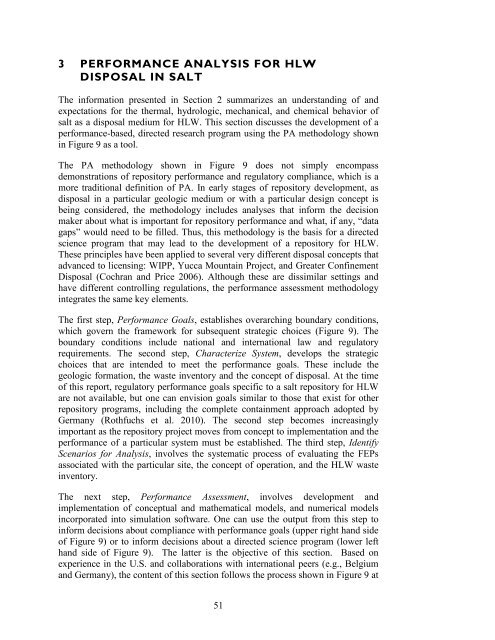Salt Disposal of Heat-Generating Nuclear Waste
Salt Disposal of Heat-Generating Nuclear Waste
Salt Disposal of Heat-Generating Nuclear Waste
Create successful ePaper yourself
Turn your PDF publications into a flip-book with our unique Google optimized e-Paper software.
3 PERFORMANCE ANALYSIS FOR HLW<br />
DISPOSAL IN SALT<br />
The information presented in Section 2 summarizes an understanding <strong>of</strong> and<br />
expectations for the thermal, hydrologic, mechanical, and chemical behavior <strong>of</strong><br />
salt as a disposal medium for HLW. This section discusses the development <strong>of</strong> a<br />
performance-based, directed research program using the PA methodology shown<br />
in Figure 9 as a tool.<br />
The PA methodology shown in Figure 9 does not simply encompass<br />
demonstrations <strong>of</strong> repository performance and regulatory compliance, which is a<br />
more traditional definition <strong>of</strong> PA. In early stages <strong>of</strong> repository development, as<br />
disposal in a particular geologic medium or with a particular design concept is<br />
being considered, the methodology includes analyses that inform the decision<br />
maker about what is important for repository performance and what, if any, “data<br />
gaps” would need to be filled. Thus, this methodology is the basis for a directed<br />
science program that may lead to the development <strong>of</strong> a repository for HLW.<br />
These principles have been applied to several very different disposal concepts that<br />
advanced to licensing: WIPP, Yucca Mountain Project, and Greater Confinement<br />
<strong>Disposal</strong> (Cochran and Price 2006). Although these are dissimilar settings and<br />
have different controlling regulations, the performance assessment methodology<br />
integrates the same key elements.<br />
The first step, Performance Goals, establishes overarching boundary conditions,<br />
which govern the framework for subsequent strategic choices (Figure 9). The<br />
boundary conditions include national and international law and regulatory<br />
requirements. The second step, Characterize System, develops the strategic<br />
choices that are intended to meet the performance goals. These include the<br />
geologic formation, the waste inventory and the concept <strong>of</strong> disposal. At the time<br />
<strong>of</strong> this report, regulatory performance goals specific to a salt repository for HLW<br />
are not available, but one can envision goals similar to those that exist for other<br />
repository programs, including the complete containment approach adopted by<br />
Germany (Rothfuchs et al. 2010). The second step becomes increasingly<br />
important as the repository project moves from concept to implementation and the<br />
performance <strong>of</strong> a particular system must be established. The third step, Identify<br />
Scenarios for Analysis, involves the systematic process <strong>of</strong> evaluating the FEPs<br />
associated with the particular site, the concept <strong>of</strong> operation, and the HLW waste<br />
inventory.<br />
The next step, Performance Assessment, involves development and<br />
implementation <strong>of</strong> conceptual and mathematical models, and numerical models<br />
incorporated into simulation s<strong>of</strong>tware. One can use the output from this step to<br />
inform decisions about compliance with performance goals (upper right hand side<br />
<strong>of</strong> Figure 9) or to inform decisions about a directed science program (lower left<br />
hand side <strong>of</strong> Figure 9). The latter is the objective <strong>of</strong> this section. Based on<br />
experience in the U.S. and collaborations with international peers (e.g., Belgium<br />
and Germany), the content <strong>of</strong> this section follows the process shown in Figure 9 at<br />
51
















